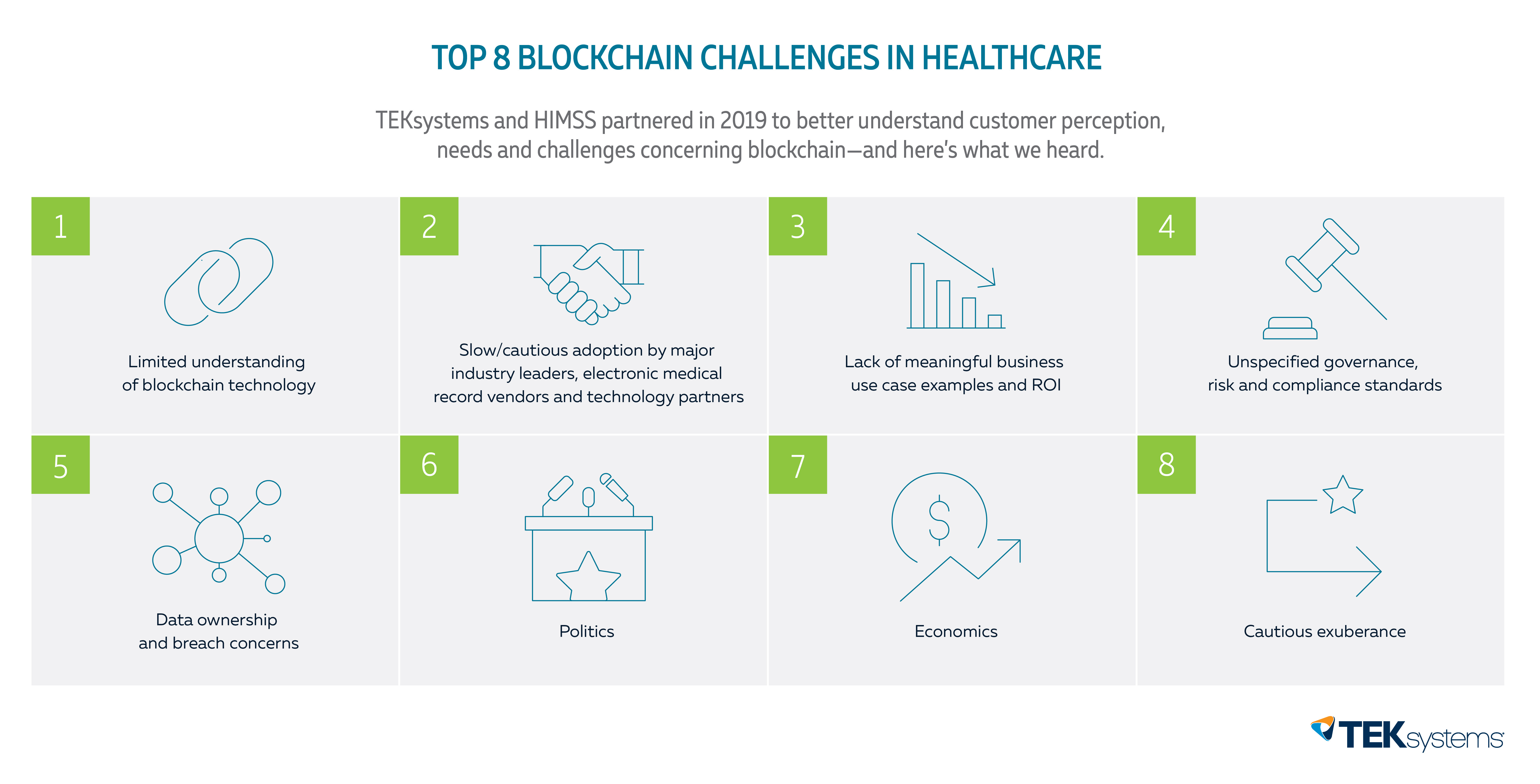Blockchain—Healthcare’s major disruptor or major disappointment?
Healthcare blockchain use cases and proofs of concepts for what could be healthcare’s next disruptive technology platform
Feb. 12, 2019 | By Ben Flock and Dennis Genetski

What is blockchain?
Blockchain, in its most basic definition, is the ability for two parties that don’t know each other to exchange value in a secure, disintermediated, transparent way. Cryptocurrency embodies the core of this definition, creating a gold rush environment for commercial opportunities and promises of disruptive “game changing” capabilities for every industry—including healthcare. But after many years into the initial hype and promises of blockchain and its disruptive potential, few healthcare industry use cases that can be quantified and monetized have surfaced.
In early 2019, TEKsystems partnered with HIMSS Analytics to better understand customer perception, needs and challenges concerning blockchain. HIMSS conducted a focus group comprising business and technology leaders from the payer, provider, pharma and public sectors. Here’s what we heard:
- Limited understanding of blockchain technology
- Slow/cautious adoption by major industry leaders, electronic medical record vendors and technology partners
- Lack of meaningful business use case examples and ROI
- Unspecified governance, risk and compliance standards
- Data ownership and breach concerns
- Politics (fear of change, risk-averse industry)
- Economics (fear of loss of control / revenue streams)
- Cautious exuberance – Feeling of game-changing potential; knowledge that they need to do something; waiting for someone to show them what, why, how
In almost equal parts, there’s enthusiasm and interest surrounding blockchain as well as considerable caution and apprehension. Everyone’s looking for the ground-breaking use case with game-changing ROI. It’s clear that there’s an immediate need for education, validation and quantification.

Start small, but start now
To ensure your organization isn’t left behind when blockchain technology goes mainstream, familiarize yourself with open source blockchain frameworks and how blockchain transactions are processed. A simple blockchain solution can be developed with relatively little time and effort using an open source blockchain platform and implementing a simple protocol to manage transactions. Leading a proof-of-concept effort can help advance your understanding of how blockchain will impact your business and prepare you to take advantage of blockchain in the future.
Blockchain is most effective in exchanging data between related or unrelated parties. Minimize risk by focusing on enhancing internal systems or applications with blockchain functionality. Eliminating external partners or sources simplifies implementation, gives you more control and can enable you to pursue efforts that’ll enhance your own processing or data flow while ensuring you won’t be left behind in the next paradigm shift.
Keep first-step blockchain implementations as simple as possible. There are several areas in which an internal blockchain implementation can show ROI on a relatively small investment.
Near-term business use cases to use as a proof of concept
Provider directory
Health insurers must provide timely, accurate patient access to provider contact information and new patient availability. Centers for Medicare & Medicaid Services (CMS) regulate provider directory services and can implement financial penalties if quality measures aren’t met. Many provider directory implementations are inefficient, costly and often manual processes. A blockchain distributed ledger capability could help establish and maintain a proactive, structured, perpetual process enabling open and direct access to provider information on an as-needed basis. Given provider directory information is public record, it’s a very good blockchain candidate for a proof-of-concept project.
Provider credentialing
To legally practice medicine, physicians are required to be credentialed. Details such as background information, litigations and score carding information must be made available and updated annually. Today’s credentialing processes are lengthy, manual and costly to providers and the practices employing them—and much of this cost is passed on as an administrative overhead expense to consumers. Blockchain technology could automate the entire credentialing process, enabling turnkey interoperability and data transparency. Credentialing offers a strong business ROI for a blockchain proof of concept.
Prior/preauthorizations
Prior authorization is a complex, costly and frustrating procedure for providers, payers and patients. Preauthorization approval for a specialty procedure often requires faxing large documents, countless manual reviews and conversations, and potentially weeks of unnecessary delays. It results in high administrative costs and adverse impact to quality of care. Blockchain could be used to disintermediate the participating entities and automate intelligent medical decisions in a secure, auditable, open access, transparent way.
Keys to a successful blockchain proof of concept
Blockchain critics continue to point to a lack of ROI or success references. Here are key elements to make sure you set your proof-of-concept project up for success.
- Secure sponsors. To start off on the right foot, you need strong business and IT sponsors committed to discovering and driving blockchain use cases, ROI and impact. The use case must be simple and straightforward, with reasons for use of blockchain fully qualified and easily understood by IT and business sponsors.
- Manage risk. Limit exposure to protected health information (PHI) / personally identifiable information (PII) and work with well-defined, clean data sets.
- Set a short time frame. Every proof of concept should be a short sprint—a 90-day project with clear, concise, measurable business impact and ROI in a 3–6-month window.
- Make it transparent. Ideally, you’re looking to create a “glass house effect,” where people can view, critique, reference, qualify and monetize. Everything you do, both successful and unsuccessful, should be referenceable and used as input/learning to help drive subsequent blockchain implementations.
Looking ahead—blockchain in the long term
Near-term proof of concepts will help you to better understand and address long-term challenges or barriers and take on more complex use cases. Blockchain can help solve some of healthcare’s most difficult business challenges, as distributed ledger technology fits perfectly where multiple parties engage in single or multiple transactions and where a single trusted source of data is required. Some of healthcare’s unique challenges—size and scope of the environment, data security requirements and third-party payment—provide enormous potential for blockchain technology but also ensure that none of the approaches bantered around today for healthcare blockchain come close to the required paradigm shift that exists on the horizon.
For healthcare blockchain to fully realize its potential as a major industry disruptor—and not a disappointment—it will require industry and technology vendors to innovate around tools and systems already in use to deliver a system that will evolve to allow a far simpler, more cost-effective implementation than most can imagine.
Ben Flock is TEKsystems’ chief healthcare strategist. He’s spent the last 30 years building innovative technology solutions that address complex business challenges in healthcare. He’s worked with Cigna, UnitedHealth Group, Aetna and Travelers. Before joining TEKsystems, he spent 12 years as Microsoft’s chief healthcare evangelist.
Dennis Genetski is a delivery executive leading engagement operations and execution for TEKsystems’ healthcare customers. He has over 20 years of experience leading technology transformation and innovation in healthcare and financial services. He is currently responsible for innovation, development and delivery of blockchain solutions.